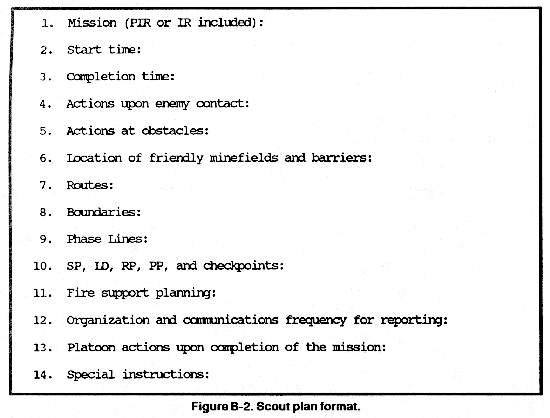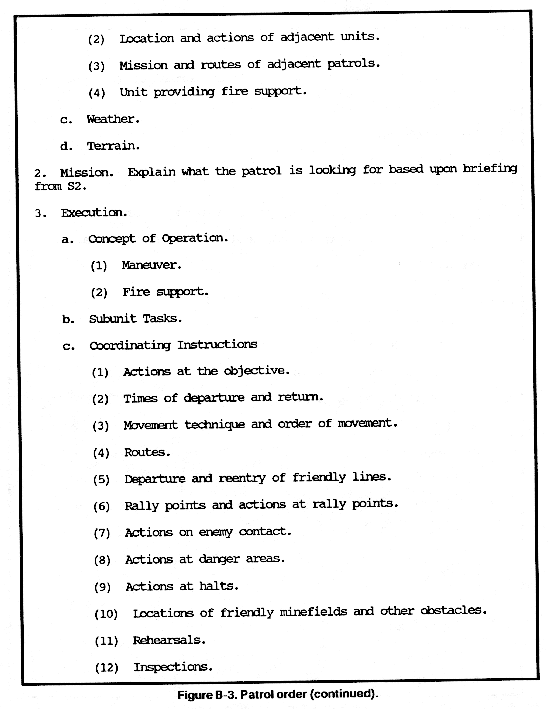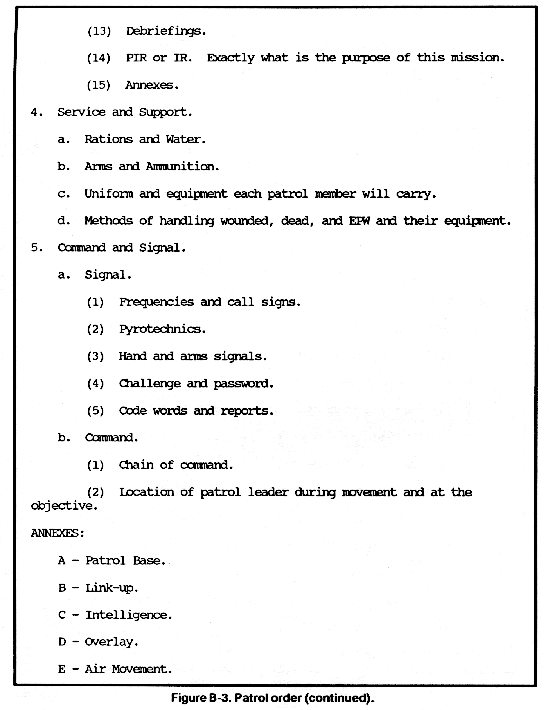RECONNAISSANCE AND SURVEILLANCE PLANNING
The ACR and separate brigade S2s are responsible for managing and planning R&S operations. The S2 ensures full surveillance coverage of the battlefield is being conducted by the squadron or battalion. The S2 does this based upon guidance from the ACR and brigade commander, corps G2, and detailed knowledge of the enemy, weather, and terrain through IPB. See FM 34-2-1 for more information on R&S operations.
NAMED AREAS OF INTEREST
The ACR or separate brigade S2 identifies some of the NAIs that the squadron or battalion S2 needs to cover in the R&S plan and gives the limit of advance for reconnaissance assets. Other NAIs to be covered will be developed by the squadron or battalion. The squadron or battalion S2 puts together the R&S plan based upon the guidance from the higher S2, commander, and mission of the unit. The squadron or battalion S2 sends a copy of the R&S plan to the ACR or separate brigade S2. The ACR or separate brigade S2 insures that no gaps exist between the squadrons or battalions and sends the entire regiment or brigade R&S plan to corps. The R&S plan is a tool that ties intelligence, maneuver, and fire support together to further develop the enemy situation and targeting process.
In order for the squadron or battalion S2 to implement an effective R&S plan, the S2 must use the following terms:
- Reconnaissance. A mission undertaken to obtain by visual observation or other detection methods, information about the activities and resources of an enemy, or potential enemy; or to secure data concerning the meteorologic, hydrographic, or geographic characteristics of a particular area.
- Surveillance. The systematic observation of aerospace surface, or subsurface areas, places, persons, or things by visual, aural, electronic, photographic, or other means.
- Security. Measures taken by a military unit, an activity, or installation to protect itself against all acts designed to or which may impair its effectiveness.
- Counterreconnissance. All measures taken to prevent hostile observation of a force, area, or place. Actions taken to counter enemy R&S efforts through the depth of the AO. It is a combat function directed by the S3 with intelligence support from the S2.
RECONNAISSANCE AND SURVEILLANCE PLAN
The purpose of the R&S plan is to find out and verify information about the enemy and terrain that affects the ground force maneuver plan using the assets of the ACR or separate brigade. These assets are scouts, aircraft, artillery FOs, MI company, engineers, chemical, infantry, and armor.
According to FM 101-5, the S3 is responsible for and has tasking authority over maneuver elements. The S2 makes recommendations to the commander or S3. The S2 is the primary user of the scouts and often tasks them. In some units the S2 has tasking authority over R&S assets after the R&S plan has been approved by the commander and the S3. Every unit has its own SOPs regarding R&S responsibilities.
The commander's approval of the R&S plan is considered as tasking authority. Many times the S3 does not have time to prepare and publish separate R&S missions, so the S2 does it. Once the S2 has written the formal plan and coordinates it with the S3, he sends it to the commander for approval. Once the commander has signed the fragmentary order (FRAGO) or warning order, the taskings within it become missions ordered by the commander, regardless of who wrote it.
STEPS FOR DEVELOPING AND IMPLEMENTING RECONNAISSANCE AND SURVEILLANCE PLAN AT SQUADRON OR BATTALION
The squadron or battalion S2 must understand the mission and commander's intent. (PIR or IR are established from these two concepts.)
- The S2 prepares a warning order to the R&S assets so they can begin preparations. R&S starts as soon as possible and continues throughout the operation.
- The S2 and the rest of the staff conduct IPB together. An R&S plan cannot be developed without NAIs and TAIs. These come directly from the IPB process.
- The S2 prepares a situation template based on what the enemy is expected to do.
- From the situation template and IPB, the S2 develops an event template. This template will assist the S2 in selecting NAIs that help confirm or deny enemy intentions. The R&S plan should focus on these NAIs.
- The S2 coordinates with the S3 to ensure that the necessary assets to employ for R&S are not already assigned a mission. He coordinates with the FSO to ensure that FA assets know where and when R&S assets will operate. The S2 briefs the officer in charge or chiefs of these assets on the enemy, weather, and terrain. The S2 uses the IPB products completed to date (such as photographs, terrain models, and R&S overlays) as part of the brief. The S2 explains what the commander wants to accomplish and what you as the S2 expect from each asset. The squadron or battalion S2 gives them the big picture and then directs them to their specific roles:
-- Do not just focus on the enemy; have the R&S assets report on terrain, obstacles, AAs, and weather effects on terrain.
-- It is imperative that all assets have primary and alternate means of communications and adequate logistics.
-- Ensure all assets report regularly, even if a negative report.
-- Have the S3 or a member of that section present at the briefing to ensure proper coordination takes place.
-- Try to augment scout missions with GSRs, FOs, and engineers to increase the information potential.
-- If time permits, write an R&S annex to the OPORD. If there is not enough time, prepare an R&S overlay and disseminate it to the units and assets.
RECONNAISSANCE AND SURVEILLANCE OVERLAY
The R&S overlay is constructed with R&S assets graphically oriented to satisfy the commander's PIR. As a minimum, the R&S overlay includes three sections: graphic display of deployed R&S assets and planned R&S deployments; a legend containing administrative data and instructions to R&S assets; and distribution.
Graphic
The R&S overlay will show--
- Number, location, and parent unit of listening post or OP.
- Patrol routes, start points, release points, and checkpoints.
- Scout screen line or locations.
- GSR primary and supplementary locations, left and right scan limits, mission and target areas.
- REMBASS.
Legend
The legend will contain--
- Required operational times.
- Coordinating instructions.
- Enemy activities likely to be detected.
- Reporting requirements.
Distribution
A distribution listing will usually contain--
- Troop or company team. Asset of officer in charge or chief.
- S3, FSO, engineers, and ACR or separate brigade S2.
QUESTIONS THAT A RECONNAISSANCE AND SURVEILLANCE PLAN SHOULD ANSWER
There are several questions that the R&S plan should answer regarding the area of the objective and the axis of advance.
Area of the Objective
- Did the reconnaissance pinpoint sufficient numbers of vehicle fighting positions, orientations, and individual emplacements to permit the S2 to accurately template enemy dispositions down to at least platoon level?
- Did reconnaissance accurately pinpoint or classify all obstacles (for example, location, dimension, type, gaps, and bypasses)?
- Did the reconnaissance, if tasked, breach obstacles, mark for day or night, and report location and type of marking?
- Did reconnaissance report the above obstacles no later than 1 hour prior to main body departure time (to permit order revision if necessary)?
- Did they withdraw undetected (stealth)?
- Was at least one OP established off the objective but able to maintain surveillance of the objective to assist with C2 and to make calls for indirect fire and adjustments during maneuver and assault?
Axis of Advance
- Did the reconnaissance cover the entire axis from the line of departure (LD) to the objective?
- Did the reconnaissance identify and answer all questions about obstacles?
- Did the reconnaissance mark the routes?
- Were OPs established overlooking the axis of advance?
- Were infiltration routes located for dismounted attack?
- Did the reconnaissance conduct at least a hasty reconnaissance of all key terrain and suspected or probable enemy locations capable of overwatching and placing effective fire into the axis of advance?
- Was the trafficability along the axis determined?
- Was all the information reported at least 1 hour prior to LD?
- If required, was reconnaissance continued beyond the objective to locate enemy positions, obstacles, possible avenues of counterattack or reinforcement, and avenues of withdrawal?
- Was a defensive screen established beyond the objective to detect and report counterattack or reinforcement?
ESSENTIAL ELEMENTS FOR RECONNAISSANCE AND SURVEILLANCE MISSION SUCCESS
There are three essential elements for R&S mission success: planning, preparing, and executing.
Planning
The S2 should--
- Create a realistic situation template for guiding the reconnaissance effort.
- Prepare a specific R&S plan, either in the OPORD or separate annex.
- Prepare the R&S plan as soon as possible and give the appropriate assets warning orders.
- Employ assets with the scouts.
- Select one person to be the leader for the R&S effort, preferably the S2.
Preparing
The S2 should--
- Ensure the assets are prepared to meet the schedule.
- Brief the mission to all participating assets.
- Rehearse the mission.
- Establish an adequate communication net for the reconnaissance effort.
Executing
The S2 should--
- Use dismounted techniques to maintain stealth.
- Ensure that reconnaissance elements maintain regular status reporting.
- Coordinate between reconnaissance assets during the mission.
- Ensure the reconnaissance element knows whether or not to engage the enemy. Most reconnaissance missions never engage unless in a life-threatening situation.
AUGMENTING ASSETS
In order for an R&S mission to achieve its maximum effectiveness, other assets should be augmented to the reconnaissance element. Example:
- Supplement FOs with the scouts to call in or change indirect fires.
- Use infantry to locate and mark infiltration routes.
- Locate tanks close enough to the reconnaissance elemental a source of protection if called upon. (It is more common to supplement tanks in the counterreconnaissance role.)
- Aviation assets often fly in and out of the squadron or battalion sector and are tasked to provide observation information. Helicopters also are used to insert R&S assets.
Reconnaissance elements frequently locate and breach obstacles or evaluate trafficability. Engineers are trained in this function and can provide timely information if added to the reconnaissance force. Signal assets can be supplemented to act as a relay or retransmission station to cover the long distances scouts usually travel during reconnaissance missions. (GSRs can also be used to do this.)
PATROL REPORTS
Patrol reports are prepared in detail, based upon the S2's debriefing of the patrol leader and other key members of the patrol. Results are relayed to potential users as combat information and are included in the S2's intelligence data base. Results of patrols are normally transmitted to the regiment or brigade S2 when obtained. Patrols will also report information of immediate use via radio to the S2, based on reporting instructions stated in the patrol plan.
Other R&S assets report combat information using SOP reporting formats or the size, activity, location, unit, time, equipment (SALUTE) spot report format. R&S assets may report on the squadron or battalion command net, operations net, intelligence net, or some combination of the three. Reporting is detailed in the instructions in the R&S plan and normally is based on the unit SOP.
FORMATS AND OVERLAYS

















